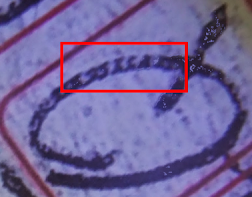Ah make the most of what we yet may spend,Before we too into the dust descend;
Dust into dust, and under dust to lie.
Sans wine, sans song, sans singer and-sans end.
An opened copy of the Rubaiyat was found on the chest of 'George' Joseph Saul Haim Marshall when his body was discovered near Taylor's Bay, Sydney on June 3rd, 1945. He had died of poisoning. The book was opened on the page that contained the verse above and a pencil mark was alongside it and. like the still to come TAMAM SHUD and its torn piece case, this verse finishes with 'END'
I decided to take a closer look at the actual verse and was surprised by what I found. Seemingly hidden within the words of this verse was the acrostic coded word DANETTA.
This same name has turned up in the Somerton Man case in both the so-called code page and in Verse 70 inscription in the book given by Jessica to Alf Boxall. Not only that but it was also found in the last letter left by the man, Tibor Kaldor, whose body was found in an Adelaide hotel room 2 weeks to the day following the death of the Somerton Man. Tibor had hidden within an acrostic code inside that note the name 'DANETTA'.
DANETTA again, another instance of the apparent coded name only this time it shows up in the MARSHALL case.
THE MARSHAL CASE INSTANCE
The method used for this kind of acrostic code was to incorporate the name DANETTA within a set of lines or a paragraph but, and it's a big but, the locations of these letters must be numbered sequentially. It is an advanced acrostic method that has been used in other codes and is documented as such.
1. The code letters can be read from left to right
2. Their position can be numbered within a word
3. or within a line
4. or within a paragraph
5. The sequence can also be read from the top or first line to the bottom line
6. or from the bottom line to the top
7. Or a combination thereof as in starts on line 3, goes to line 4 then moves back up to line 3 etc.
The Marshall case verse:
Top line down reading left to right:
D, Third line first word and the first letter in line, D
A, Fourth line, first word 'Sans' second letter A
N, Fourth line first word 'Sans', third letter N
E, Fourth line, the second word 'Wine", fourth letter E
Reverse, bottom to top line reading right to left:
T, Third line, the second word in 'to', 5th letter in the line letter T
T, Third line, the third word in 'dust', 6th letter in the line letter T
A, First line, the second word in 'may', 7th letter in the line, letter A
The same acrostic code word DANETTA appears in numerical sequence in the Marshall case verse.
Three Dead Men
This could, of course, be a coincidence, three dead men, two copies of the Rubaiyat one with a hidden code that contains the word DANETTA in the numerical sequence and the other two have DANETTA within a verse in the numerical sequence.
Further, In Verse 70 inscription in Alf Boxall's copy of the book, the acrostic coded word DANETTA is present also in the numerical sequence
Again, this same word, DANETTA was first discovered with another dead man found poisoned in Adelaide 2 weeks to the day after the Somerton Man was found. Tibor Kaldor's last letter/suicide note contains the Acrostic coded word DANETTA, this discovery being made with the use of an acrostic decoder.
Finally, the acrostic coded word DANETTA was found in numerical sequence in the ad for a 'Lost Gold Watch' placed with Prosper's phone number as a contact.
Three dead men, all three having died by poisoning.
A total of six instances of this acrostic coded word and all in strict numerical sequence.
Coincidence?
THE SEQUENCING IS KEY
In years gone by, it was asserted by some that you can make the name up from lots of paragraphs that contain the necessary letters. Yes, that's true but, it is far more difficult, though not impossible, to make the name when you use an acrostic positioning method and one that is based on a seven consecutive numbers system.
Here we have six instances related to the deaths of 3 men and in which the Rubaiyat figures in two of those cases. All three men died of poisoning, two died in Adelaide within days of each other in 1948 and one died in Sydney some 3 years earlier.































